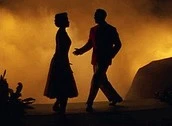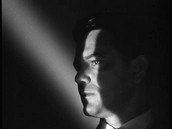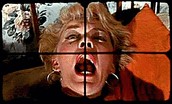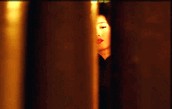© 2014 by James Clark
When we come to a film as bizarre as Nicolas Refn’s Valhalla Rising (2009), we are, perhaps unbeknown, placed within large demands to get to the bottom of its expressive design. The work appears at first glance to be a study of sorts concerning the ways of Nordic tribes in the late medieval period (say, 1000 AD) where a pagan (Viking?) ethos finds itself troublesomely confronted by the clerkish circumspection of bands galvanized by Christianity. At the outset, we are put on notice, along such lines, by this signage: “In the beginning there was only man and nature. Men came bearing crosses and drove the heathen to the fringes of the earth.” Judging from the Scottish dialect of the non-heathens here, we would seem to be dipping into the ethnology of early Britain. (Valhalla Rising was in fact filmed in Scotland, spilling our way as concentrated a swatch of disturbing atmosphere as you’re ever apt to see—unremittingly dark and damp and stark, with winds close to blowing the cast off of the planet, reminding us of the inclement features of Robert Altman’s McCabe and Mrs. Miller, filmed in another weather hell, Canada.)
But if the concern of Valhalla Rising were at all driven by the romance of history, we would not, surely, see so much Gothically chic wardrobe—not unlike the garb on display in expensive, media-zone restaurants. Nor would we have a camera-angle, during a tense confrontation, where the protagonist’s battle axe is poised like a big pistol in a holster. Nor would we have a Man with no Voice, unmistakably giving off a (highly inflected, of course) version of the Man with No Name. (Actor, Mads Mikkelsen, provides a similarly handsome tautness of skin and expressivity of eye.) The protagonist’s loyal companion, a young boy with Scandinavian hair, tells him, during one of the myriad tight spots they occupy, “You need a name. You’ve only got one eye…” This near-banter within a narrative plunge so heavily steeped in violent death, while seeming to fit nicely within the glory days of Clint Eastwood, does, in fact, bring us to the point of realization that Valhalla Rising no more closely stalks early film than it stalks early history. (For good measure, Refn has apparently done his bit to muddy the waters by referring to this movie as “science fiction,” especially thrilled by Stanley Kubrick’s 2001: A Space Odyssey.)
The quip about needing a name sends us to the business of a figure, mute, but on close inspection fully aware of the conversation coming his way, and having devised a strategy to disarm it. His silence, as I think we’ll come to recognize, is as formidable a weapon as his bare hands and his axe—and, in that, it comprises a double edged sword, a trusty stabilization in a context of deadly derangement; and an atrophied medium of interpersonal discovery. His having only one eye (presumably gouged out at an earlier stage of his enforced practise of the craft of kill-or-be-killed-exhibitions for a market in need of couth) silently speaks to that far less evident and far less readily comprehended deficit.
Let’s, then, begin by way of that scene where the boy points out to him that minimalism can be carried too far. They’ve escaped, in a shower of enemy blood, from the porn circuit and have come upon an encampment of pious Celts, where in fact their leader is on his knees in prayer before a cross. (Also catching our eye is a group of women huddled together under an armed guard—disconcertingly naked [McCabe’s dismal early brothel pops up] in that frigid air, and somehow missing out on the demonstrative delicacy as advertised.) The chubby attendant to that early YWCA blurts out that, “He’s one of the biggest savages in Sutherland… He killed our chieftain’s son… most of his men as well…” That displaced swordsman lets us in on details of the film’s outset, showing how the professional blood sport has become a staple in that territory. But even more to the point, he takes his place as one of a panoply of straight men in this settlement, to the minimal black comedy our protagonist displays a powerful flair with. From the moment that quasi-ventriloquist-team comes into view, its singular micro-climate induces the anal rustics to exorcize them along lines of reciting their ownership of a multifaceted bulwark against every dangerous feature intrinsic to existence. The chieftain leads off with, “Are you from the clans, Warrior?” It is the boy who hesitatingly says, “No,” an interactive peculiarity that especially prompts the edgy leader to demand, “Why does the boy speak for ya?” One Eye fixes him with a suspenseful glare, establishing the ground rules as he understands them to involve deadly (if necessary) resoluteness always having the advantage. His frustration and anxiety mounting, the local alpha barks out, “You Christians?” And after a pause, uncomfortable to the little blonde, his androgynous demeanor being a special irritant in a patriarchal orbit, he replies quietly, “Yes.” Pulling his sword out of the mud where he’d parked it during prayers, the commander snarls, “Yer lyin’,” calls to his son, who approaches, locks eyes with One Eye and his gunslinger axe-angle, takes out his sword, notes with shock that his adversary pictures him as already a corpse—and, with a funereal-apt raw glint hanging over the moors, his father steps up and the boy withdraws. Now exposed as not competent for conflict, the leader retreats with a touch of patently empty bravado—“Does the mute have a name?”—to which the young boy (now more than ever a page) replies, “His name is One Eye.” (Seeing his unofficial master less than pleased with that invention, he reasons, “You only have one eye;” but with the harder truth, “You need a name,” he proves he belongs, rendering in fact a fundamental reminder about the gallantry, the creative recognition of others, implicit in the discharge of his fighting efficiencies.) “One Eye, ye can eat with us,” is where things go next, and during the meal, while the Man with a New Name silently disses these self-assertive nuisances, both poles of this confrontation are looking for what they can exploit from the other.
The setting of this dinner is arresting: almost complete darkness with not so much as an ember to evoke the merest spark of interaction, and everyone seated on the absolutely unattractive moor. The convenor asks, “So, how did you get your freedom? What do you plan to do with it?” One Eye imperiously looks toward the topography, pointedly stressing his seeing that the fretful hosts know nothing about freedom and are whistling Dixie if they think he owes them any accounts of his priorities. The flaccidity of these correspondents confirms him in a sufficiency of communing with his own carnal composure. The Sutherland body-counter suggests, “Maybe he could bring us luck;” and the commander follows with, “I could use a good fighter like you… We’re God’s own soldiers, Warrior. Heading to Jerusalem to reconquer the Holy Land…” The look on One Eye’s face at this moment can only be well comprehended with regard to the time of his captivity, when—confined to a wooden cage and with shackles trailing from an iron collar, and then taken out to fight for his life while being chained to a pole like a bear in a bear pit—attending to that indispensable composure and efficacy afforded by silence was all that could make sense to him. Now prodded by garrulous cowards, he would assimilate the desperation and volume of the rhetoric as both contemptible and ludicrous; but there would be something more than a sterile standoff. “There’s great honor in it [the reconquest]… riches, land” [and here the boy looks over at One Eye, and the look on his face is to communicate his strong desire for avoiding violent rupture. He told the leader, “I wanna go home…/ “Where is that?”/ “Dunno…”]. Another greybeard, but with a more agile fluency, regarding the warrior’s being underwhelmed by the chief’s pitch (we see One Eye in close-up and in profile, and the speaker is some distance removed, leaning on a boulder), declares, “Endless warfare [capturing a bit of interest]… But it makes more tramps than heroes…But you should come with us to Jerusalem. Yer sins will be absolved, whether you live or die. Ye will see yer loved ones again.”
Though most viewers come away from Valhalla Rising with the priority of having seen “senseless violence” (perhaps even more viewers come away from it with that idea in having avoided seeing it at all), I maintain that it is a compelling reflective drama, written and produced with rewarding verve. As we complete our survey of a passage valuable in navigating exactly where this far from straightforward or simplistic movie is going, we should notice that the boy with scraggly blonde locks often covering his face progresses, in light of the sustained poise of his companion being at perfect pitch for the occasion, to a bit of playful intimidation of his own. Someone from out of that celebratory gloom asks, “Boy! Where does he come from?” After thinking a moment, he declares, “He was brought up from hell…” We see the supposed hellion in profile, and off a ways someone asks, “So where is this hell?” And the boy pipes up, “On the other side of the ocean…” Perhaps twigging to the fact that they are being ridiculed by the kid, the locals, led by the theologically erudite second-in-command, return to the unearthly prize which One Eye represents to them. “It’s more than revenge… all these things go… You should consider your soul… That’s where the real pain lies…” With this, One Eye turns and looks hard into the speaker’s face. Then we are face on and up close to the stranger. Something more than contempt informs his stance.
That his pensive profile as becoming a pensive face-on amidst the darkest of clouds, the most shattered of moors and the shrieking gales transposes to the rippling waves in a Scottish bay at the beginning of a huge gamble that represents his only move, has to be bolstered here by introductory action we’ve left until now. One Eye and the boy, the most unlikely of crusaders, have to be introduced as the most desperately isolated and besieged of voyagers. Far from a government-endorsed space odyssey affording adventuring in the grand style, theirs is practically the quintessence of that “tight spot” the Coens’ Ulysses makes a mockery of. As we proceed with details of their truly epic and thereby truly revealing distress, we are, when looked at trenchantly enough, truly engaged by Refn’s wildly inflected researches in “science fiction.”
So now is the time to pull away from the badinage which defines our protagonists as earthy outsiders, to savor for a moment the quite unique intensity of a state of “home” requiring improvement. The first shot—showing a figure (the boy) at long distance trudging along a hillside with a pail of water, almost completely lost in thick fog and almost swallowed up by the impenetrable darkness of the moors—keys the narrative setting in such a way as to emphasize that we have entered a protagonistic field where the human and the non-human meet in an uncanny, dangerous interplay. Even before we clearly focus on our main figures, then, we are aware that names are startlingly irrelevant. The insistent ringing motif complements that fusion, with the added factors of mortal danger and stunning hostility. The recipient of the water is not only locked into a timber-sided cage; his hands are bound, and as we regard that condition we can see that animal-like tattoo images invade his arms and back. This situation unfolds to an action of the boy’s tending to open wounds on his charge’s back. His being restrained, during these attentions, by chains trailing from his neck further installs into the viewer’s startlement, at such a state of distemper, that this figure has more in common with wild beasts than with the human community and its discharge of security measures as crude as they are mawkish. The lumpen guards are insinuated, by these means, into a base facsimile of the prisoner, in his carnal integrity, and the boy, raptly applying a black poultice to the sores. Therefore, as the next scene explodes in our face, showing the leashed warrior smashing an overturned opponent repeatedly, to the sounds of broken bones, there is a panning shot displaying the promoters of this mayhem, crumpled like anxious fungi as seated around the battlefield. A monkey-like local with a blanket over his shoulders comes up to an authority-type, receives some coins and wobbles through the assembly, stopping to give some of the handicapped money to a bettor. There is more such testing of One Eye’s physical powers, his being a creature conversant with a battle terrain of wet muck and with deploying his body to destroy an alien body. But the point to especially concentrate upon is the aftermath of two more (Sutherlanders’?) crushed skulls, when the one-eyed survivor, being tethered to return to his outer-limits home, holds out his hands, fists clenched. With that gesture, he traces the intensive concentration that defines his days; and, moreover, he touches upon the reversal of that tightness, a flux in proximity to the readily overlooked graces of that ominous highland. The elder who payed out the winnings comes to the cage with a sour visage. We notice with some surprise another such pen, in the distance. We also note a bit more brightness in the gloom. One Eye calmly glares back at such a cheap master. But, in fact, master no more, as the following scene has another aspirant (in fact the fungus paid off by the monkey) to stage such tempestuous theatre and wagering. The latter tells the sour one, “You’re time has passed… Mine has come…”
The transfer of One Eye develops in many fresh ways the scenario’s bringing about a strange planet with its divide between those who only grasp and those whose grasp becomes part of a startling equilibrium. The episode begins with One Eye asleep in his cage, the wind howling. He dreams of a river of blood, and then he is chest-deep in it, the river shimmering, and rocks on both shores. The dream includes his taking a big rock and bashing in the skull of an enemy with it—a brutal materiality of slaughter ensuring that his purchase upon equilibrium could not be divested of its nightmarish associations. Heavily chained and guarded, he is seen in a column lunging across difficult terrain in that terrible wind. He is intent and calm as he surveys a promising volatility. Allowed to be watered like a horse, in a pool of shimmering, clear water, he stands chest-deep in a new avenue for action. The boy watches him from the shore, his concern very distinct from that of the guards also on hand. What with the clean water trumping the bloody waves in his dream (just as the boy trumps the jailors), he occupies a zone of absolute silence and stillness. Then he looks down into the water, sees something promising for a change and submerges toward it (not unlike finding couth where hitherto it was savagery all the way). Picking up an ancient arrowhead, he studies it for a bit, underwater, savoring the beauty of its lines and texture, and its useful aspects; and then he puts it in his mouth and surfaces to face those he has to defeat. At night he studies his gift from the world-wide world, from one far-away expert to another. He tests its sharpness by cutting his hand with it, after which he clenches his fist on the wound. As he fills his heart in this way, the outmanoeuvred old pagan rails against his prevailing rival—“Bastards! Eat his flesh. Drink his blood. Abominable! We pray to the gods to protect us… We have many gods. They’ve only got the one! Won’t let him go. We need him…” And the rival rubs it in, his white-collar violence a rational component of the dead ends facing our protagonist. “You need money… like everyone else…It’s the only way to reason with the Christians… You might as well get it from me.” They shake hands, and the new force clenches his fists, looking across an infinite gulf to the fighter, who is even more proudly silent than we saw him before.
In accordance with the new ownership, One Eye travels with his head covered by a black cloth. The cloth has protuberances that resemble ears. Donkey ears! He strides across that terrain and his legs are closely filmed; they are greyish and the texture of the covering of a quadruped. He begins to free with that sharp edge his neck restraints under that convenient and thought-provoking temporary skin. Ripping off his mask, he’s on track to be much more like the tiger than the donkey. (And yet, has there ever been a more Balthazar-like beast of burden, showing seemingly endless capacity to endure hardship? Balthazar, though, you may recall, was also devoted to sharing love, the big question mark posed by this film.) Quickly acquiring an axe, he uses it very effectively and before you know it he’s not only a free agent but he has tied to a rock one of those too petrified to challenge him or run away. The captive has no eye for One Eye’s slight progress toward buoyancy. Surprisingly for so inept a warrior, this diminutive road kill has quite a mouth on him. He rudely rallies the former slave and lax communicator, with, “What do you see? When I die, you will go back to hell.” Having spent years being insultingly categorized as lacking valuable perceptive traction (while in fact not being one to miss the point that everyone around him is far from impressive), he performs an execution of that vox populi which, while clearly lacking Arthurian gallantry, constitutes a bellwether of sorts concerning a toxic irritant much more, in fact, germane to the twenty-first than to the eleventh century. As a means of measuring how confined he remains within that “endless [physical] warfare,” he comes up to the cheeky prisoner and with his bare hands rips out his guts, plopping them on the unfertile land like a load of fertilizer. We are given a close look at one of the victim’s hands, quivering and then freezing, very unlike the kinetic expertise of the outsider having come to relish savaging those precious smartasses on the other side. The kiss-off from a life having been unspeakably annoying consists of mounting the head of one of those mainstream underachievers at the top of one of those neck-bars that would always have been a presence of his routines. Their partnership now on new footing, the boy shows him a ring and asks (not so puzzlingly in view of One Eye’s appreciation of fine craft), “Do you like it? My father gave it to me…” But now the escapee has turned to the dilemma of nowhere to turn; coming to his imagination is his face smeared with blood. Also he considers the sea as a way to rejuvenate his hitherto cramped, humiliating endeavors.
Coming upon those quixotic sailors and their cut-and-dried travel objectives, One Eye bids to make the best of a long-shot. In accordance with the farcical incompetence of his new associates, the ship promptly runs across a protracted passage of doldrums (where the setting is like a liquid desert). The old theoretician, kindly enough thinking to relieve the discomfort of the only child onboard, tells the little stranger (who has, as we know, seen much worse), “Do you know what I do when I’m scared?” [for instance, now]… The boy, whose repertoire of equilibrium does not run to panaceas, shakes his head at this puzzling juncture. And that elicits the emergency supply, “I pray to Christ.” On seeing how puzzled and noncommittal the mascot is, the officer asks, “Do you know who he is?” The boy shakes his head again, no longer feeling compelled to butter up a fighting force which One Eye has effectively subdued. “He sacrificed his life so that we could be free… from pain and misery… So you have to be strong…” The boy does not need such a reminder, and it shows. Moreover, One Eye, who had been listening close by, makes a gesture (cut mid-way) of spitting on the floor in face of this presumptuous authority. Both of them, then, at this point, are impervious to the prospect of giving the time of day (mustering a loving sacrifice of their self-sufficiency) to hated enemies, as propelling life forward. This quiet display of repulsion is not lost upon the rest of the crew perched about the deck in a prostration resembling a diseased aviary. Soon the impulsive former attendant to the ladies is thinking out loud, “Perhaps it’s a curse.” During prayers for delivery away from a deadening sunlight haze, the one who floated the idea of a curse (only to be rebutted by the chief) notices how indifferent the two strangers are. So, on the heels of another bloody nightmare visiting One Eye, the obsessive tells his mates, in focusing on the far more easily managed child, “I’m gonna kill him.” Another action hero steps forward, declaring, I’ll do it,” but before he can use his dagger One Eye has chopped a hole in his torso and thrown his corpse overboard. The leader tells his noisily upset crew, “Back off!” And while the complaining from them goes nowhere, the situation of our protagonists’ alienation has been underlined once again, in order that the eventful saga of the destination not lead to blind alleys.
Before the wind does get back to business, and the little ship ends up somewhere (though not Jerusalem), the chief, true-blue dour Scot that he is, recalls, “The boy said he was from hell,” and infers, “Maybe that’s where we’re going.” And though several Canadians might concur in the epithet, “hell,” the scene does in fact shift to a Scottish facsimile of the Labrador/Newfoundland coast, in the form of a sparkling blue estuary with skies of hitherto unseen blue and pine forests and sub-Arctic meadows all round. Though miffed from many angles, the crusaders, led by the somehow charismatic chief and his theological advisor, seamlessly (Celtic whimsy in full force) shift into taking this clearly Nordic locale for the Holy Land. (For all the blood-curdling pistons of his scenarios, Refn is an impressive exponent of situational comedy.) There is, however, also, about this flood of bracing landscape, an indicator, at a subliminal pitch, that our protagonists now occupy a terrain where the constraints upon their bringing into play an opening of the clenched fist have been somewhat relaxed. After the spate of compulsive, self-justifying chatter with which the crusaders have bombarded the strangers and us, we now effectively occupy an expressive zone closely resembling dance and its special investigation of the challenges and rewards implicit in silent motion. At the early stages of the scouting mission on foot, anticipation begins to take on the property of malaise, inasmuch as they come upon wooden platforms (vaguely echoing One Eye’s cage) where corpses lie, perhaps implying famine. One Eye, now more in the capacity of Swiss Guard than a reluctant novice/companion to the elect, tensely surveys the hinterland of this oddly callous statement. The chief says, “I’m gonna show them a man of God has arrived;” but One Eye is no longer absorbed by obviating him. He interrupts a circle of silent prayer by plunging the sword of a crewman, who had ventured off alone, into the soil. “Where did you get that?” someone asks. One Eye barely notices such impertinence, his attention galvanized by his and the boy’s project now beginning to crash and burn. The fat loudmouth offers, “You killed him!” One Eye doesn’t even look his way, his attention in fact focused on the river below their vantage point. The leader commands them to row the ship further upstream, to “find out where we are…” One Eye joins in the rowing, a moment of unity at a point he knows to be a foolish venture. Soon an arrow rips into a crusader, blood gushing and much howling. The boy is horrified; One Eye impassively looks into the dimension of death; and the crew, swords drawn (clearly the wrong weapon) commences what spins from a military to a mystical exercise. Were the point to simply exterminate the invaders, more arrows would be flying. One Eye becomes dead calm (the boy still distraught) in realizing that he’s become once again part of a sadistic entertainment. (The owner of the sword One Eye put into the puzzle does show up, stripped, painted upon and quite insane.)
Now expecting death to strike them at any moment, the entire invading force silently plays out a series of bizarre personal observances. That One Eye and the boy also come within this thrust places them in a highly inflected context of kinship with vastly unforthcoming traditionalists. One Eye washes the blood from the arrow that depleted the crusade. The design beauties of the arrowhead in the pool are clearly invoked again, for their resonant powers. Though the leader can’t resist revealing a perdurant ideological insanity (“We claim this land…”), many of his followers dispense with doctrine and enact primal, almost infantile rites. The Sutherland source of distemper comes upon someone who had prayed at an altar-like rock formation and gone on to slog through the jet-black muck of the tidal flats. He pushes the latter’s face and the rest of his head into the wet, black substance in some kind of assertion of powers he doesn’t possess. With a grinding sound design becoming more insistent, One Eye has a premonition of a blood-soaked attack upon him. He tries to balance rocks in a column formation. Fails; and a bit later he tries again and succeeds—his way with craft calling to him as a significant stand. The chubby aggressor demands that they return; the leader vetoes that idea with, “We’ve raised the cross! Now we bring the sword!” One Eye looks on in silent contempt. In one disastrous outburst, the contrarian declares to the chief, “One Eye took us to hell. And there is no God!” He pulls out his dagger and lunges at the protagonist, who slashes his throat with his axe. The subsequent repeated chopping him to bits, blood splashing up, underlines One Eye’s realization that sustained harmony has no hope.
He strides away from his odious travelling companions and he stops to look back at the boy, who then follows him into the hills. Some stragglers try to follow them, including the leader’s careful son. During a pause from negotiating the high country, the latter regards the two strangers standing together. “What did he say?” he asks the boy. “We’re gonna die,” is the answer. “Then he’s lyin’!” the son insists. One Eye’s slight smile at this point contains no joy. The son turns back to join his father who has already been felled by many arrows. The boy sadly beholds the old theologian, a man of hope, who smiles at him. Then the protagonists reach the salt water of the estuary, and a numerous band of natives appears. One Eye gives the boy a little smile (their telepathy in fact having given solace on many occasions) and he touches his arm. He proceeds toward the locals who have their fun. Then, in vague recognition of the warrior’s integrity, they leave the boy unharmed, which is to say, to starve like the folks on the platforms. But unlike those folks, he’s seen something of the world and its promise, over and above its savagery.
























 Click on names for archives
Writers/Founders
Click on names for archives
Writers/Founders
This acid-trip, Viking tone poem of a film sharply divided the critical establishment, and continues to provoke discussion, praise and derision. An often searing meditation on violence and religion, the work could be seen as more of a painting or poem than a film, and there is some acute kinship to Malick and Herzog. Mads Mikkelson (who was so superlative in THE HUNT) gives an electrifying performance, and the score is magnificent. Jim you have penned an unprecedented piece of scholarship on this film, one that for the very start makes a persuasive case for ‘expressive design’ as the best way to make heads or tails of this often oblique and difficult film that nonetheless sheds some aesthetic rewards for those willing to stay the course.
Thanks, Sam.
I chose Valhalla at this juncture to emphasize that the issues of grace, so brilliantly delivered by Inside Llewyn Davis and Her (and by The Great Beauty, up next), are haunted by the primordial spectre of deadly violence (which does not begin and end with physical violence) so obsessive to Refn. That there is in the sublime The Great Beauty a nod to One Eye’s premonitions of gore brings us to the fascinating collegial situation obtaining within a posse of filmmakers you might not imagine to have much in common.
One figure who does not make the cut is Pier Pasolini, a filmic big name who has a lot to say about expressive design but allows his combattive motives to run amok, thereby undermining his filmic pertinence. And soon I’ll be be considering what’s up and what’s down with him.
I’ve always had a tough time with this one. The parts never seemed to add up to much. Still I have admired some of the director’s other films and can see why it would bring on such an intricate study. Great essay btw. That’s a given. I would have to agree that Mikkelson’s work was hard to shake.
Thanks, Frank. I seriously want you and other readers to think this is open to all.
Valhalla Rising is very much a difficult film, particularly in view of its cadence of multiple homicide and relentless disappointment. We are tempted to shoot back, “Life’s not this bad, Buddy!” I think, however, that Refn, that young Grim Reaper, is well aware that he’s laying it on a bit thick. Like so many of his cohorts (Tarantino, von Trier and Lynch immediately come to mind), he’s steamed about more civilized dead ends and devises black, black comedies to catch the flavor of dismay with world history’s loyalists. Comedy is key here—and Refn’s comedy is perhaps the most difficult to twig on to. It’s the password to finding graceful traction, communion with modest souls where others (Pasolini, for instance) flounder.
Though most viewers come away from Valhalla Rising with the priority of having seen “senseless violence” (perhaps even more viewers come away from it with that idea in having avoided seeing it at all), I maintain that it is a compelling reflective drama, written and produced with rewarding verve.
After everything is added up I’d say I completely agree Jim. The film is not what it seems, and there’s more to be appreciated in multiple viewings. Your own case for a much deeper understanding is presented in astounding collegiate form.
Thanks, Peter.
Your point, about the film being “not what it seems,” importantly takes us into the often very difficult job of catching up with the tonality of violence in cinema. So much blood is shed in films and on TV that I think many viewers have come to approach the flood as one continuous stream of The Texas Chainsaw Massacre, going crazily (but, for them, amusingly) way beyond any thematic exigencies. But it would be, in my opinion, a big mistake to think that all filmmakers showing copious violence have the same motives. For marketing reasons, many of the more demanding exponents present a facade of just wild and crazy guys having fun like all the rest. But they also serve up, for those able to concentrate, dilemmas of integrity that the strictly commercial entertainments have no time for.
A fascinating variation of this matter consists of Pasolini’s also having very little time for those entirely phenomenal crises and consequently emiting more or less crude renditions while having all the equipment to accomplish so much more.